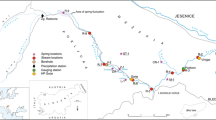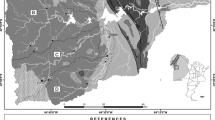Abstract
The hydrogeochemical and isotope characteristics of the River Idrijca, Slovenia, where the world’s second largest mercury (Hg) mine is located, were investigated. The River Idrijca, a typical steep mountain river, has an HCO3 −–Ca2+–Mg2+ chemical composition. Its Ca2+/Mg2+ molar ratio indicates that dolomite weathering prevails in the watershed. The River Idrijca and its tributaries are oversaturated with respect to calcite and dolomite. The pCO2 pressure is up to 13 times over atmospheric pressure and represents a source of CO2 to the atmosphere. δ18O values in river water indicate primary control from precipitation and enrichment of the heavy oxygen isotope of infiltrating water recharging the River Idrijca from its slopes. The δ13CDIC values range from −10.8 to −6.6‰ and are controlled by biogeochemical processes in terrestrial environments and in the stream: (1) exchange with atmospheric CO2, (2) degradation of organic matter, (3) dissolution of carbonates, and (4) tributaries. The contributions of these inputs were calculated according to steady state equations and are estimated to be—11%:19%:30%:61% in the autumn and 0%:26%:39%:35% in the spring sampling seasons.






Similar content being viewed by others
References
Agency of Republic of Slovenia for the Environment (2006–2007) Monthly bulletin, No 1–12 (in Slovene)
Amiotte Suchet P, Probst JL (1993) Modelling of atmospheric CO2 consumption by chemical weathering of rocks: application to the Garonne, Congo and Amazon basins. Chem Geol 107:205–210
Amundson R, Austin AT, Schuur EAG, Yoo K, Matzek V, Kendall C, Uebersax A, Brenner D, Baisden WT (2003) Global patterns of the isotopic composition of soil and plant nitrogen. Global Biogeochem Cycles 17:1031
Anderson SP, Drever JI, Frost CD, Holden P (2000) Chemical weathering in the foreland of a retreating glacier. Geochim Cosmochim Acta 64:1173–1189
Barth JAC, Cronin AA, Dunlop J, Kalin RM (2003) Influence of carbonates on the riverine carbon cycle in an anthropogenically dominated catchment basin: evidence from major elements and stable carbon isotopes in the Lagan River (N. Ireland). Chem Geol 200:203–216
Ben Othmann D, Luck JM, Tournoud MG (1997) Geochemistry and water dynamics: application to short time-scale flood phenomena in a small Mediterranean catchment. I. Alkalis, alkali-earth and Sr isotopes. Chem Geol 140:9–28
Broecker WS (1974) Chemical oceanography. Harcourt Brace Jovanovich, New York
Broecker HC, Peterman J, Siems W (1978) The influence of wind on CO2-exchange in a wind-wave tunnel, including the effects of monolayers. J Mar Res 36:595–610
Buser S (1987) Geological map of Slovenia. In: Encyclopedia of Slovenia no 8. Mladinska knjiga, Ljubljana (in Slovene)
Clark I, Fritz P (1997) Environmental isotopes in hydrogeology. Lewis Publishers, New York
Coplen T (1988) Normalization of oxygen and hydrogen data. Chem Geol (Isotope Geosci Sect) 72:293–297
Craig H (1961) Standard for reporting concentrations of deuterium and oxygen-18 in natural waters. Science 133:1833–1834
Dever L, Durand R, Fontes JCh, Vaicher P (1983) Etude pédogénétique et isotopique des néoformations de calcite dans un sol sur craie. Caractéristiques et origines. Geochim Cosmochim Acta 47:2079–2090
Devol AH, Hedges JI (2001) Organic matter and nutrients in the mainstem Amazon River. In: McClain ME, Victoria RL, Richey JE (eds) The biogeochemistry of the Amazon basin. Oxford University Press, New York, 365 pp
EIONET (2005) European environment information and observation network. http://eionet-en.arso.gov.si. Cited 11 Nov 2005
Elderfield H, Upstill-Goddard R, Sholkovitz ER (1990) The rare earth elements in rivers, estuaries and coastal seas and their significance to the composition of ocean waters. Geochim Cosmochim Acta 54:971–997
Epstein S, Mayeda T (1953) Variations of 18O contents of water from natural sources. Geochim Cosmochim Acta 4:213–224
Fairchild IJ, Bradby L, Sharp M, Tison JL (1994) Hydrogeochemistry of carbonate terrains in alpine glacial setting. Earth Surf Process Land 19:33–54
Fairchild IJ, Killawee JA, Hubbard B, Dreybrodt W (1999) Interactions of calcareous suspended sediment with glacial meltwater, a field test of dissolution behaviour. Chem Geol 155:243–263
Fairchild IJ, Borsato A, Tooth AF, Frisia S, Hawkesworth CJ, Huang Y, McDermott F, Spiro B (2000) Controls on trace element (Sr-Mg) compositions of carbonate cave waters: implications for spelothem climatic records. Chem Geol 166:255–269
Gaillardet J, Dupre B, Allegre CJ (1999a) Geochemistry of large river suspended sediments: silicate weathering or recycling tracer? Geochim Cosmochim Acta 63:4037–4051
Gaillardet J, Dupre B, Louvat P, Allegre CJ (1999b) Global silicate weathering and CO2 consumption rates deduced from the chemistry of large rivers. Chem Geol 159:3–30
Gat RJ (1996) Oxygen and hydrogen isotopes in the hydrological cycle. Annu Rev Earth Planet Sci 24:225–262
Gibbs RJ (1972) Water chemistry of the Amazon River. Geochim Cosmochim Acta 36:1061–1066
Gieskes JM (1974) The alkalinity-total carbon dioxide system in seawater. In: Goldberg ED (ed) Marine chemistry of the sea, vol 5. Wiley, New York, pp 123–151
Goldstein SJ, Jacobsen SB (1987) Rare earth element in river waters. Earth Planet Sci Lett 89:35–47
Gonfiantini R (1986) Environmental isotopes in lake studies. In: Fritz P, Fontes JCh (eds) Handbook of environmental isotope geochemistry, vol 2. Elsevier, Amsterdam, pp 113–168
Hedges JI (1992) Global biogeochemical cycle: progress and problem. Mar Chem 39:67–93
Hedges JI, Clark WA, Quay PD, Richey JE, Devol AH, Santos UM (1986) Compositions and fluxes of particulate organic material in the Amazon River. Limnol Oceanogr 31:717–738
Holland HD (1978) The chemistry of the atmosphere and oceans. Wiley, Hoboken, 351 pp
Holley EH (1977) Oxygen transfer at the air–water interface. In: Gibbs RJ (ed) Transport processes in lakes and oceans. Proceedings of the symposium on transport processes in the ocean held at the 82nd national meeting of the AICE, Atlantic City, NJ, August 29–September 1, 1976, pp 117–150. Plenum Press
Hu MH, Stallard RF, Edmond JM (1982) Major ion chemistry of some large Chinese rivers. Nature 298:550–553
Huh Y, Tsoi MY, Zaitsev A, Edmond JM (1998) The fluvial geochemistry of the rivers of Eastern Siberia: I. Tributaries of the Lena River draining the sedimentary platform of the Siberian Craton. Geochim Cosmochim Acta 62:1657–1676
Ittekkot V (1988) Global trends in the nature of organic matter in the river suspensions. Nature 332:436–438
Jacobson AD, Blum JD, Walter LM (2003) Reconciling the elemental and Sr isotope composition of Himalayan weathering fluxes: insights from the carbonate geochemistry of stream waters. Geochim Cosmochim Acta 66(19):3417–3429
Jähne B, Heinz G, Dietrich W (1987) Measurements of the diffusion coefficients of sparingly soluble gases in water. J Geophys Res 92:10767–10776
Kanduč T, Ogrinc N, Mrak T (2007a) Characteristics of suspended matter in the river Sava watershed, Slovenia. Isotopes Environ Health Stud 43:369–385
Kanduč T, Szramek K, Ogrinc N, Walter LM (2007b) Origin and cycling of riverine inorganic carbon in the Sava River watershed (Slovenia) inferred from major solutes and stable carbon isotopes. Biogeochemistry 86:137–154
Karim A, Veizer J (2000) Weathering processes in the Indus river basin: implications from riverine carbon, sulfur, oxygen and strontium isotopes. Chem Geol 170:153–177
Levin I, Kromer B, Wagenback D, Minnich KO (1987) Carbon isotope measurements of atmospheric CO2 at a coastal station in Antarctica. Tellus 39 B:89–95
Liu Z, Zhao J (2000) Contribution of carbonate rock weathering to the atmospheric CO2 sink. Environ Geol 39:1053–1058
Meybeck M (1982) Carbon, nitrogen and phosphorus transport by world rivers. Am J Sci 282:401–450
Meybeck M (1993) Natural sources of C, N, P and S. NATO ASI series, vol 14. Interactions of C, N, P and S, biogeochemical cycles and global change. Springer-Verlag, Berlin, pp 163–193
Miyajima T, Yamada Y, Hanba YT (1995) Determining the stable isotope ratio of total dissolved inorganic carbon in lake water by GC/C/IRMS. Limnol Oceanogr 40(5):994–1000
Mook WG, Bommerson JC, Staverman WH (1974) Carbon isotope fractionation between dissolved bicarbonate and gaseous carbon dioxide. Earth Planet Sci Lett 22:169–176
Négrel P, Lachassagne P (2000) Geochemistry of the Maroni River (French Guiana) during the low water stage: implications for water–rock interactions and groundwater characteristics. J Hydrol 237:212–233
Ogrinc N, Fontolan G, Faganeli J, Covelli S (2005) Carbon and nitrogen isotope composition of organic matter in coastal marine sediments (the Gulf of Trieste, N Adriatic Sea): indicators of sources and preservation. Mar Chem 95:163–181
Palmer SM, Hope D, Billett MF, Dawson JJ, Bryant CL (2001) Sources of organic and inorganic carbon in a headwater stream: evidence from carbon isotope studies. Biogeochemistry 52:321–338
Parkhurst DL, Appelo CAJ (1999) User’s guide to PHREEQC (version 2)—a computer program for speciation, batch-reaction, one-dimensional transport, and inverse geochemical calculations. Water-Resources Investigations Report 99-4259
Petelet E, Luck JM, Ben Othmna D, Négrel Ph, Aquilina L (1998) Geochemistry and water dynamics on a medium sized watershed: the Herault, S France. Chem Geol 150:63–83
Radinja D (1990) Idrijca. In: Javornik M, Voglar D, Dermastia A (eds) Encyclopedia of Slovenia. Mladinska knjiga, Ljubljana, 98 pp
Reeder SW, Hitchon B, Levinson AA (1972) Hydrogeochemistry of the surface waters of the Mackenzie River drainage basin, Canada: 1. Factors controlling inorganic composition. Geochimica Cosmochim Acta 36:181–192
Roulet N, Moore TM (2006) Browning the waters. Nature 444(16):283–284
Roy S, Gaillardet J, Allègre CJ (1999) Geochemistry of dissolved and suspended loads of the Seine River, France: anthropogenic impact, carbonate and silicate weathering. Geochim Cosmochim Acta 63:1277–1292
Six J, Elliot ET, Paustian K (2004) Soil macroaggregate turnover and microaggregate formation: a mechanism for C sequestration under no-tillage agriculture. Soil Biol Biogeochem 32:2099–2103
Spötl C (2005) A robust and fast method of sampling and analysis of δ13C of dissolved inorganic carbon in ground waters. Isotopes Environ Health Stud 41:217–221
Staddon PL (2004) Carbon isotopes in functional soil ecology. Trends Ecol Evol 19:148–154
Stallard RF, Edmond JM (1983) Geochemistry of the Amazon 2. The influence of geology and weathering environment on the dissolved load. J Geophys Res 88(C14):9671–9688
Szramek K, McIntosh JC, Williams EL, Kanduč T, Ogrinc N, Walter LM (2007) Relative weathering intensity of calcite versus dolomite in carbonate-bearing temperate zone watersheds: carbonate geochemistry and fluxes from catchments within the St. Lawrence and Danube river basins. Geochem Geophys Geosyst 8:1–26
Tao S (1998) Spatial and temporal variation in DOC in the Yichun River, China. Water Res 32:2205–2210
Telmer K, Veizer J (1999) Carbon fluxes, pCO2 and substrate weathering in a large northern river basin, Canada: carbon isotope perspectives. Chem Geol 159:61–86
Urbanc-Berčič O (1999) Aquatic macrophytes in the rivers Sava, Kolpa and Krka. Ichthyos 1:23–34
Vreča P, Kanduč T, Žigon S, Trkov Z (2004) Isotopic composition of precipitation in Slovenia. In: Isotopic composition of precipitation in the Mediterranean basin in relation to air circulation pattern and climate: final report of a coordinated research project 2000–2004 (IARA-TECDOC, 1453). IAEA, Vienna, pp 157–172
Yang C, Telmer K, Veizer J (1996) Chemical dynamics of the ‘St. Lawrance’ riverine system: δDH2O, δ18OH2O, δ13CDIC, δ34Ssulfate, and dissolved 87Sr/86Sr. Geochim Cosmochim Acta 60:851–866
Yee P, Edgett R, Eberhardt A (1990) Great lakes—St. Lawrence River regulation; what it means and how it works. Joint publication of Environment Canada Ontario Region, and the U.S. Army Corps of Engineers
Zhang J, Quay PD, Wilbur DO (1995) Carbon isotope fractionation during gas–water exchange and dissolution of CO2. Geochim Cosmochim Acta 59(1):107–1146
Acknowledgments
The authors are grateful to Mr. Stojan Žigon, Mrs. Leonida Mehle and Corey Lambert for technical support. The authors acknowledge financial support from the state budget by the Slovenian Research Agency and programme research group “Cycling of nutrients and contaminants in the environment, mass balances and modeling environmental processes and risk analysis” (P1-0143). Special thanks are given to Anthony Byrne for linguistic corrections.
Author information
Authors and Affiliations
Corresponding author
Rights and permissions
About this article
Cite this article
Kanduč, T., Kocman, D. & Ogrinc, N. Hydrogeochemical and Stable Isotope Characteristics of the River Idrijca (Slovenia), the Boundary Watershed Between the Adriatic and Black Seas. Aquat Geochem 14, 239–262 (2008). https://doi.org/10.1007/s10498-008-9035-2
Received:
Accepted:
Published:
Issue Date:
DOI: https://doi.org/10.1007/s10498-008-9035-2




